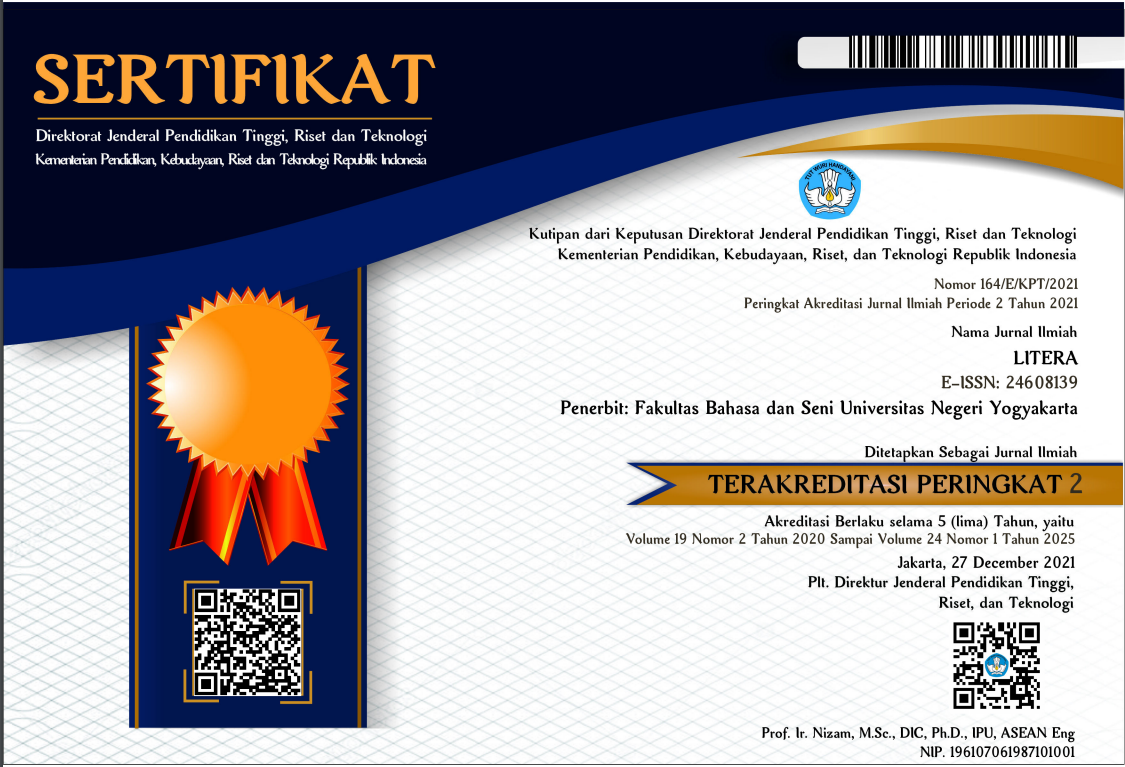EVALUASI KUALITAS ARGUMEN PADA ARTIKEL JURNAL
Downloads
Argumentasi sangat penting dalam artikel ilmiah. Oleh karena itu, penelitian ini bertujuan mengungkap kualitas argumentasi dalam artikel ilmiah pada jurnal dengan scope pendidikan bahasa Indonesia. Kualitas jurnal akan dievaluasi berdasarkan perspektif Toulmin. Evaluasi dipaparkan dalam pembagian kualitas argumentasi, struktur varian yang tampak dalam paragraf argumentasi, dan peringkat kualitas argumentasi pada jurnal terindeks sinta 2 sampai 6. Untuk mengungkap kualitas argumen tersebut, peneliti menggunakan pendekatan mixed method. Hasil temuan dari penelitian ini, pertama: secara umum kualitas argumen dalam artikel yang berfokus pada pendidikan bahasa Indonesia masih rendah. Argumen secara dominan disajikan dengan struktur P-D. Kedua, terdapat empat varian struktur argumen yang ditemukan, yaitu: P-D, P-D-J, P-D-T, dan P-D-J-T. Ketiga, kualitas argumen berdasarkan nilai rerata konversi menunjukkan jurnal terakreditasi sinta 2 memiliki kualitas masuk pada klasifikasi sedang. Sementara artikel pada jurnal terakreditasi 3, 4, 5, 6 dan tidak terakreditasi memiliki kualitas argumen tergolong pada kategori rendah.
Kata kunci: kualitas argumen, wacana, perspektif toulmin
EVALUATING THE QUALITY ARGUMENT IN JOURNAL ARTICLES
Abstrak
Arguments are very important in scientific articles. This study aims to reveal the quality of arguments in scientific articles in journals with the scope of Indonesian language education. The quality of the journal will be evaluated based on the Toulmin's perspective. Evaluation is described in the division of argumentation quality, variant structure that appears in the argumentation paragraphs, and argumentation quality ratings in indexed journals 2 to 6. To reveal the quality of the arguments, the researcher uses a mixed method approach. The findings of this study are as follows. First: in general, the quality of the arguments in articles that focus on Indonesian language education is still low. The argument is predominantly presented with a P-D structure. Second, there are four variants of the argument structure found, namely: P-D, P-D-J, P-D-T, and P-D-J-T. Third, the quality of the argument based on the average conversion value shows that the Sinta 2 accredited journals have medium classification. Meanwhile, articles in accredited journals 3, 4, 5, 6 and un-accredited have the quality of their arguments in the low category.
Keywords: quality of arguments, discourse, Toulmin's perspective
Downloads
Abdollahzadeh, E., Amini Farsani, M., & Beikmohammadi, M. (2017). Argumentative Writing Behavior of Graduate EFL Learners. Argumentation. https://doi.org/10.1007/s10503-016-9415-5
Abduh, N. K., Sastromiharjo, A., & Anshori, D. S. (2019). POLA ARGUMENTASI PADA GENRE TEKS EKSPOSISI KARANGAN SISWA SMA. RETORIKA: Jurnal Bahasa, Sastra, Dan Pengajarannya. https://doi.org/10.26858/retorika.v12i1.7372
Allagui, B. (2019). Writing a Descriptive Paragraph Using an Augmented Reality Application: An Evaluation of Students' Performance and Attitudes. Technology, Knowledge and Learning. https://doi.org/10.1007/s10758-019-09429-2
Ardianto, A. (2015). STRUKTUR ARGUMEN DALAM WACANA KARYA TULIS ILMIAH MAHASISWA. LITERA. https://doi.org/10.21831/ltr.v14i1.4402
Berland, L. K., & Reiser, B. J. (2011). Classroom communities' adaptations of the practice of scientific argumentation. Science Education. https://doi.org/10.1002/sce.20420
Creswell, J. (2013). Qualitative, quantitative, and mixed methods approaches. In Research design.
Denzin, N. K., & Lincoln, Y. (2011). Disciplining the Practice of Qualitative Research. In The SAGE Handbook of Qualitative Research.
Ditlitabmas, D. I. K. T. I. (2014). Pedoman Akreditasi Terbitan Berkala Ilmiah.
Hewings, A., Lillis, T., & Vladimirou, D. (2010). Who's citing whose writings? A corpus based study of citations as interpersonal resource in English medium national and English medium international journals. Journal of English for Academic Purposes. https://doi.org/10.1016/j.jeap.2010.02.005
Kathpalia, S. S., & See, E. K. (2016). Improving argumentation through student blogs. System. https://doi.org/10.1016/j.system.2016.03.002
Knudson, R. E. (1994). An Analysis of Persuasive Discourse: Learning How to Take a Stand. Discourse Processes. https://doi.org/10.1080/01638539409544892
Lam, Y. W., Hew, K. F., & Chiu, K. F. (2018). Improving argumentative writing: Effects of a blended learning approach and gamification. Language Learning and Technology.
McDermott, M. A., & Hand, B. (2010). A secondary reanalysis of student perceptions of non-traditional writing tasks over a ten year period. Journal of Research in Science Teaching. https://doi.org/10.1002/tea.20350
Miles, M. A. (1994). Miles and Huberman (1994)- Chapter 4.pdf. In Qualitative Data Analysis: An Expanded Sourcebook.
Moeliono, A. (2004). Pengajaran Bahasa Indonesia untuk tujuan akademis. Linguistik Indonesia (pp. 209–226).
Nippold, M. A., & Ward-Lonergan, J. M. (2010). Argumentative writing in pre-adolescents: The role of verbal reasoning. Child Language Teaching and Therapy. https://doi.org/10.1177/0265659009349979
Permenristekdikti. (2018). Peraturan Menteri Riset, Teknologi dan Pendidikan Tinggi Nomor 9 Tahun 2018 Tentang Akreditasi Jurnal Ilmiah. In Direktorat Jenderal Penguatan Riset dan Pengembangan.
Preiss, D. D., Castillo, J. C., Flotts, P., & San Martín, E. (2013). Assessment of argumentative writing and critical thinking in higher education: Educational correlates and gender differences. Learning and Individual Differences. https://doi.org/10.1016/j.lindif.2013.06.004
Qin, J., & Karabacak, E. (2010). The analysis of Toulmin elements in Chinese EFL university argumentative writing. System. https://doi.org/10.1016/j.system.2010.06.012
Rusfandi. (2015). Argument-Counterargument Structure in Indonesian EFL Learners English Argumentative Essays: A Dialogic Concept of Writing. RELC Journal. https://doi.org/10.1177/0033688215587607
Sampson, V., & Clark, D. B. (2011). A Comparison of the Collaborative Scientific Argumentation Practices of Two High and Two Low Performing Groups. Research in Science Education. https://doi.org/10.1007/s11165-009-9146-9
Setyaningsih, Y. (2016). POLA ARGUMEN PARAGRAF ARGUMENTATIF PADA ARTIKEL JURNAL TERAKREDITASI BIDANG EKONOMI (PERSPEKTIF STEPHEN TOULMIN). AdabiyyÄt: Jurnal Bahasa Dan Sastra. https://doi.org/10.14421/ajbs.2016.15202
Simon, S. (2008). Using Toulmin's Argument Pattern in the evaluation of argumentation in school science. International Journal of Research and Method in Education. https://doi.org/10.1080/17437270802417176
Stapleton, P., & Wu, Y. (Amy). (2015). Assessing the quality of arguments in students' persuasive writing: A case study analyzing the relationship between surface structure and substance. Journal of English for Academic Purposes. https://doi.org/10.1016/j.jeap.2014.11.006
Sudaryanto, D. P. (2015). Metode dan aneka teknik analisis Bahasa (Method and technique of language study). In Sanata Dharma University Press.
Toer, P. A. (1990). Rumah Kaca. Wira Karya.
Toulmin, S. E. (2003). The uses of argument: Updated edition. In The Uses of Argument: Updated Edition. https://doi.org/10.1017/CBO9780511840005
Toulmin, S. E. (2012). The Layout of Arguments. In The Uses of Argument. https://doi.org/10.1017/cbo9780511840005.007
























